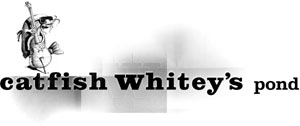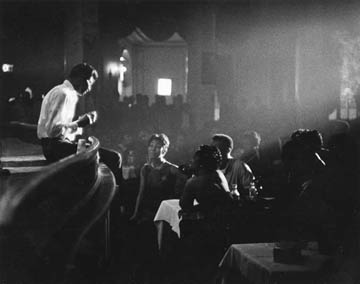 |
 |
|
|||||||||||||||||||||||||||||||||||||||||||||||||||||||||||||
 |
close to the edge | ||||||||||||||||||||||||||||||||||||||||||||||||||||||||||||||
|
I can see the scene so vividly. Hear the soulful music. Smell the beer and mixed drinks. Feel the thickness of the cigarette smoke rising to the high ceilings from every table. It’s early 1964, just past one a.m., and he’s right behind the curtains, letting the tension build so he can step out onto the stage of Chicago’s cavernous Trianon Ballroom at exactly the right second. The spotlight cuts through the smoke as he steps into the spotlight. He’s wearing a light tux, tailored to move perfectly with his body — and Jackie Wilson knows how to make it move just right. He stretches his arms straight out in front of him like a preacher, and the flock is instantly keyed to every word and gesture. Often, caught in the moment, one or a few will head for the stage to touch the sex machine, to bathe in the perspiration of the coolest performer alive.
He pirouettes, his lithe legs a blur of motion. I can see the faces of the people at the tables across the stage as we all marvel at Wilson’s voice soaring out of control up and down the octaves, the charisma dripping like the sweat from his fevered brow. I wasn’t anywhere close to the Trianon that night, of course. I was safely ensconced in a parochial boarding school in Concordia, Missouri, mourning John F. Kennedy and watching the Beatles on The Ed Sullivan Show. I remember that night through the eyes of Raeburn Flerlage, who was there at the Trianon snapping photographs. Several shots from that series, and an impressive collection of Flerlage’s best photos of Muddy Waters, Howlin’ Wolf, Magic Sam, Sunnyland Slim, Willie Dixon, Little Walter, Little Brother Montgomery and many others, have finally made their way out of his South Side Chicago file drawers and onto the pages of Chicago Blues: As Seen From the Inside (ECW Press, Ontario, Canada, 2000), a book put together by Flerlage, his wife Luise and editor Lisa Day. Talk about someone being in the right place at the right time — Flerlage’s work is familiar to any blues fan, even if his name isn’t so well known. From his South Side base he was, among many other things, a photographer for Down Beat magazine in the 1950s and ’60s, often accompanying editor Pete Welding on his rounds. His photos have graced numerous album and CD covers for several decades, and that’s his shot of B.B. King on the cover of Charles Keil’s classic tome, Urban Blues. Flerlage’s work has been an integral part of this magazine as well. Scott Barretta, now editor of Living Blues, wrote a story about Bob Koester, "The Monarch of Delmark" (BA #30). During one of our phone conversations while the story was in production, Scott mentioned Flerlage, suggested I call him and gave me his phone number. You know what happens when you talk to someone for the first time and things just click? That’s what happened with Ray. At the time, we had begun using photo spreads, mostly photo galleries of photographers whose work we admired. When I tried to explain that I wanted to take it a step further and create photo spreads that told stories, I could almost see his eyes light up over the phone. He said that he had been going through his photos again, re-evaluating his work, and asked me to send him some issues of the magazine. I didn’t hear from him right away, but in mid January 1998, I got a letter. I felt he had been reading my mind. "I don’t really feel qualified to analyze your magazine’s scope and personality," he wrote in his understated prose style. "But I wondered if you might use a photo essay involving between 6 and 12 B&W photos with any of the following approaches." Space prohibits listing all the choices, but suffice to say that there were four different Muddy Waters groupings — including Muddy at Pepper’s, the famous South Side blues club; onstage at the Downbeat Jazz Festival with Dizzy Gillespie in the band; and being interviewed by Mike Bloomfield in Muddy’s living room. Then there were variations on several performers in action on-stage at Pepper’s or Theresa’s, another well-known South Side blues haunt. Ray also included five variations on an idea we had discussed on the phone: that moment of contact that happens between performers and their audience. His suggestions included Jimmy Reed, B.B. King, Bobby Bland and Jackie Wilson "getting close to the edge" at the Trianon Ballroom and in front of "tables with snazzily dressed girls in smoky clubs." All these, and hints of B.B. King at the Regal and Little Walter "putting it on" at Mandel Hall. "There could be a hundred more," he wrote. "But that’s probably enough to chew on for awhile." A hundred more? The first package of photos left me with plenty to chew on — I must have spent an entire afternoon poring over the 30 or so black-and-white 8x10s of Wilson on that night, as well as some fascinating side-stage shots of B.B. King at the Regal and a couple more of Bobby Bland being mobbed by young women in front of the stage. The resulting photo essay, "Making Contact," was one of many reasons that BA #30 (with Mose Allison on the cover) ranks as my favorite of the 20 issues or so we published while I occupied the managing editor’s chair. It represented a major breakthrough in the way we considered photo spreads and led to several fine essay-type galleries, including a more expansive view of Flerlage’s work and career in BA #35 and a ghostly Howlin’ Wolf performance series in BA #39. It’s the way Flerlage captures the humanity in performers that really distinguishes his work, and I’m not sure anybody has ever caught the two sides of Howlin’ Wolf as well. On one page of the book are a couple of kinetic pics of Wolf clowning onstage at Silvio’s in front of less than a dozen people. On another is the X-ray-like series featured in BA #39. "Onstage," Flerlage writes, "Howlin’ Wolf performed in a menacing, rough, gruff, sometimes absurd way, with all kinds of facial contortions, clowning and grandstanding." About another shot of Wolf at home, a stately and proud Chester Burnett speaking with a very young Michael Bloomfield for a Rhythm and Blues magazine feature, Flerlage adds: "At the same time, he didn’t want to be viewed like that in ‘real life.’ He wanted to be seen as he is here, sitting in his easy chair with a pipe, like a Southern gentleman." I never got the chance to run one photo that particularly intrigued me. It’s the one that accompanies this column: Jackie Wilson, his white shirt soaked with sweat, sitting on the end of the stage apron, his eyes and those of an admirer catching each other in the spotlight just at the second Flerlage’s finger hits the shutter. Not surprisingly, it’s also the cover shot of Chicago Blues. As a person who’s spent most of his adult life chasing after those flashes of clarity in musical performance, this shot represents — better than any I’ve ever seen — that wonderful epiphany that drives all of us, every fan who reads this or any other music magazine, to stand in some ramshackle nightclub ’til it shuts down, or suffer through yet another mediocre compact disc, until we reach that one moment that drives us wild. Thanks to Ray Flerlage and Chicago Blues: As Seen From the Inside, we’re able now to relive some of those fantastic moments we missed. — Leland Rucker Former BLUES ACCESS managing editor Leland Rucker now edits web sites for a living when he’s not working on his golf game.
|
|
|
 The
mere act of taking off his coat is an erotic fantasy come alive, bringing
ecstatic squeals of pleasure from women crowding the stage area. He
teases, pulls back, teases, pulls back. A woman in a fancy fur comes
onstage and grabs the mike, and Jackie falls back on his heels, feigning
surprise and submission with the precision of a Tai Chi master.
The
mere act of taking off his coat is an erotic fantasy come alive, bringing
ecstatic squeals of pleasure from women crowding the stage area. He
teases, pulls back, teases, pulls back. A woman in a fancy fur comes
onstage and grabs the mike, and Jackie falls back on his heels, feigning
surprise and submission with the precision of a Tai Chi master.